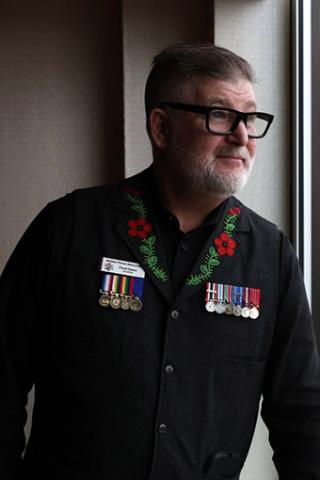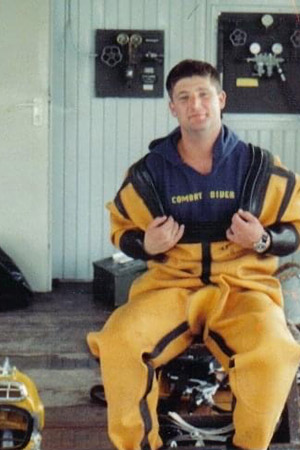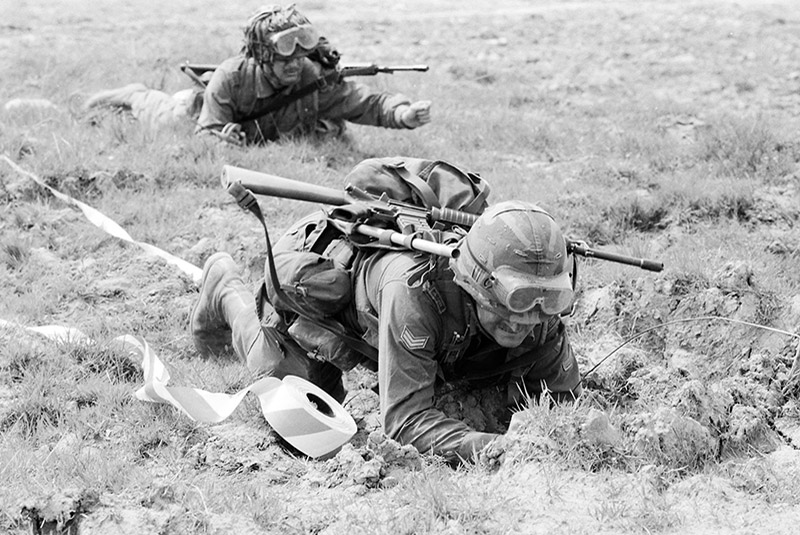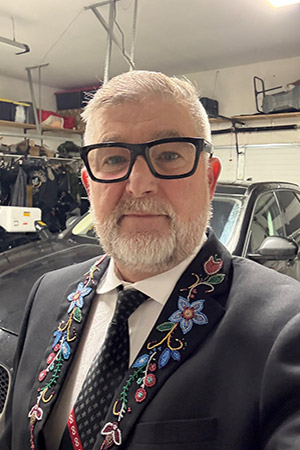
Joined
1985
Deployments
- Bosnia
For Sgt. (retired) Chuck Isaacs, service didn’t end with his retirement from a long, brave, and exhilarating military career. In many ways, it began again—with a fight to be seen, heard, and healed as an Indigenous Veteran.
A demanding new role

Chuck Isaacs in his military diving wetsuit.
Born in Castlegar, British Columbia, and raised in Victoria near the Songhees reserve, Isaacs’ Scottish, Irish, English, French and Indigenous roots reflect Canada’s complex history.
In 1985, he enlisted with the Canadian Military Engineers in Victoria, B.C., eventually becoming a combat diver—a role that demanded intense physical and mental resilience.
He served in Bosnia during the height of Canadian involvement in the Balkans. There, he helped develop mine clearance drills that are still used by the North Atlantic Treaty Organization (NATO) today.
His military career led him through minefields, into the depths of oceans, and eventually into a confrontation with the physical cost of service.
Family history of service
Growing up in a family steeped in uniform—his father a Korea and Egypt Veteran and a special constable, his grandfathers both Veterans of the Second World War—Isaacs saw service as his family duty. When he joined, he passed his fitness test on the first try. What followed was a physical transformation.
“I wasn’t overly athletic before, but once I was in, I got mentored by physical phenoms,” he recalls. “If the unit was running five miles, I’d warm up with ten. One Saturday, hungover in Germany, I ran 68 kilometers just to ‘shake it off,’” he said with a laugh.
That level of fitness would prove essential. Isaacs was selected for one of the Canadian Forces’ most grueling roles—combat diver. The selection process was brutal.
“They weeded out 26 people out of 30, mostly through physical punishment—push-ups, crab walks, runs until you broke,” he said.
Only the most capable were chosen. “People suffered ruptured diaphragms. But that’s what it took.”

Chuck Isaacs leads a T Breach during Counter Landmine drills. Germany 1991
First ones in, last ones out
As a diver, Isaacs was trained in mobility and counter-mobility: clearing or destroying obstacles for troop movement, building bridges and rafts, cratering roads, laying or removing mines.
“Engineers are first in, last out,” he says.
“We’d recce areas before the infantry moved in. I wasn’t just clearing paths—I was writing the drills to make sure others got through safely.”
His mine clearance drills were used across the former Yugoslavia. He built strong relationships with Bosnian clearance teams. In one incident, he neutralized a live grenade booby trap outside a mayor’s home—wrapped only in toilet paper, its pin already pulled.
“I could’ve walked away,” he says. “But I didn’t.”
Medical release
But his service came at a steep cost. Exposure to cement dust led to severe vision damage, retinal detachments and glaucoma.
Medically released in 2001, he returned to a civilian world unable to meet his needs as an injured Veteran—especially as an Indigenous one.
Advocacy for other Indigenous Veterans

Chuck Isaacs dressed in a Métis beaded jacket, which was hand beaded by his wife, Sandy Isaacs.
“I didn’t grow up on a reserve,” he explains. “I wasn’t raised in a traditional community. But I’ve always carried the spirit of my ancestors with me—and I’ve felt the disconnect that so many Indigenous Veterans talk about. You come back from serving your country, and you feel like you don’t belong anywhere.”
For many Indigenous Veterans, that disconnection is compounded by systemic barriers—difficulty accessing benefits, cultural insensitivity and the lingering effects of intergenerational trauma from residential schools and colonization.
For generations, Indigenous people have stood on the front lines of Canada’s conflicts and peacekeeping missions. From the First and Second World Wars, Korea, and Afghanistan to domestic operations and peace missions abroad—Indigenous soldiers, sailors, and aviators have served with distinction, but often without recognition.
Isaacs knows those stories well from daily phone calls with struggling Veterans; from the paperwork he’s filled out on behalf of others who struggled with the process to access benefits; and from friends he lost to suicide. When they returned home, many found themselves navigating a new kind of battlefield: a civilian world that did not understand their service and a system that was never built with them in mind.
Through grassroots leadership, community outreach, and persistence, Indigenous Veterans are supporting one another. They often volunteer their time, resources, and knowledge to lift others up, reconnect, and reshape the systems that were meant to serve them.
That’s why Isaacs is committing his post military life to raising awareness and building systems of support.
In Alberta, where he now lives, Isaacs has become a powerful advocate for Indigenous Veterans. He serves as president of the Aboriginal Veterans Society of Alberta, mentors others through the claims process, shares his knowledge of policy and history, and—most importantly—listens. Not as a caseworker, but as a comrade.
“Sometimes what someone needs most is to know they’re not forgotten,” he says.
“We don’t leave our people behind. That’s not just a military value—it’s a cultural one.”
Issuing a challenge
Issacs is also issuing a challenge to governments, to the public, and to fellow Canadians:
“Honouring Indigenous Veterans isn’t just about parades or plaques. It’s about action. It’s about standing up for the people who stood up for this country—people who were warriors long before they wore a uniform.”
As Canada moves forward in reconciliation, Isaacs reminds us that some of our most powerful changemakers are already among us: Veterans who carry not only the weight of war but the wisdom of their ancestors.
With courage, integrity and loyalty, Chuck Isaac is leaving his mark. He is a Canadian Armed Forces Veteran. Discover more stories.
The well-being of Canadian Veterans is at the heart of everything we do. As part of this, we recognize, honour and commemorate the service of all Canadian Veterans. Learn more about the services and benefits that we offer. If you contact VAC and self-identify as an Indigenous Veteran, you have the option to be connected with Indigenous Services Canada to receive culturally-safe and mental wellness services in addition to existing VAC benefits and services, including Peer Support.
If you are a Veteran, family member or caregiver, the support of a mental health professional is available anytime at no cost to you. Call 1-800-268-7708.